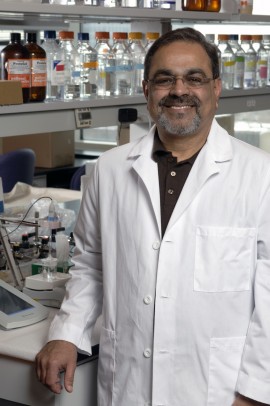Can diabetes be treated by blocking beta cells’ destruction?
A unique approach to treating type 1 diabetes that protects insulin-producing cells from attack by the body’s immune system will be tested at the University of Illinois at Chicago College of Medicine in hopes that it could free patients from the need for daily insulin injections.
Bellur S. Prabhakar, professor of microbiology and immunology, has received a two-year, $475,000 grant from JDRF, a global organization funding type 1 diabetes research, to test the efficacy of two protein molecules that may hold the immune system in check, sparing the beta cells of the pancreas from autoimmune destruction.
“The reason the immune system attacks the pancreatic beta cells in type 1 diabetes is because certain immune cells whose job it is to stop this from happening are asleep at the wheel,” Prabhakar said.

Bellur S. Prabhakar, professor, microbiology and immunology. Photo: Roberta Dupuis-Devlin/UIC Photo Services.
The immune system produces a broad arsenal of T cells to recognize and destroy all sorts of bacteria and viruses. But some of these cells will wrongly perceive the body’s own cells as foreign. In a healthy person, these errant “effector” T cells are repressed by watchdog cells called regulatory T cells. People with type 1 diabetes — 1.25 million in the U.S. — don’t produce enough regulatory T cells to halt the wayward effector T cells from wreaking havoc in the pancreas.
“The holy grail for type 1 diabetes researchers has been to figure out a way to amplify the number of regulatory T cells without also amplifying effector T cells,” Prabhakar said.
Previous attempts have relied on recognizing T cells by the unique receptors on their membranes, but this method amplifies both the effector T cells as well as the regulatory T cells. Approaches aimed at first isolating the regulatory T cells from blood before amplifying those with the relevant receptors have proved to be expensive and cumbersome — and would need to be repeated frequently.
Prabhakar and colleagues have shown that regulatory T cells can be amplified selectively using two specialized protein molecules called OX40L and JAG1. The molecules bind to receptors only found on regulatory T cells, and together spur the cells to multiply. Experimental mice with type 1 diabetes that were treated with the mouse versions of the two molecules were found to have more working regulatory T cells, more intact islet cells, and normal blood sugar levels.
The researchers will use the grant funding to test the ability of human OX40L and JAG1 to selectively amplify human regulatory T cells grown in the laboratory and in experimental mice that carry a human immune system. They will also use the experimental mouse model to test an engineered protein that combines parts of OX40L and JAG1 into a single molecule.
“If we can show that the two human proteins can selectively restore healthy numbers of functional regulatory T cells, then we may have a treatment for type 1 diabetes that requires an injection every couple of weeks instead of insulin injections multiple times a day,” Prabhakar said. Besides convenience, such a treatment would offer other possible benefits, including perhaps a reduction of risks associated with type 1 diabetes that insulin treatment doesn’t eliminate, such as nerve and retina damage.
Palash Bhattacharya and Muthusamy Thiruppathi, both research assistant professors of microbiology and immunology in the UIC College of Medicine, are co-investigators on the JDRF grant.
